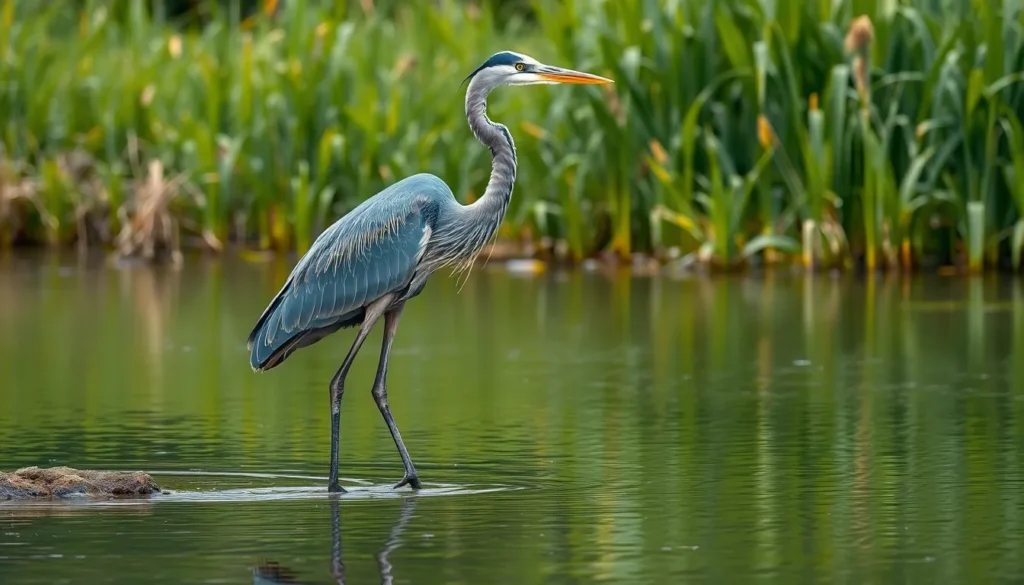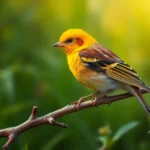We’ve all witnessed that magical moment when a graceful heron stands motionless at the water’s edge, transforming from statue to lightning-fast predator in seconds. These magnificent wading birds captivate us with their patience, precision and striking appearance that’s remained virtually unchanged for millions of years.
From the towering Great Blue Heron to the secretive Night Heron, we’re about to explore the intriguing area of these remarkable creatures. Whether you’ve spotted one during your morning jog or you’re curious about that elegant bird you photographed last weekend, herons offer some of nature’s most compelling behaviors and adaptations.
We’ll uncover their hunting strategies, nesting habits and the incredible diversity within the heron family. You’ll discover why these ancient birds continue to thrive across every continent except Antarctica and how their presence signals healthy ecosystems in our communities.
What Is a Heron Bird
Herons belong to the family Ardeidae, which encompasses 72 species of wading birds distributed across every continent except Antarctica. These large birds possess distinctive long legs, elongated necks, and sharp beaks perfectly adapted for their aquatic lifestyle. Most heron species measure between 12 to 60 inches in height, with the Goliath Heron being the largest at up to 5 feet tall.
The anatomy of herons reflects their specialized hunting requirements. Their necks contain 20-21 vertebrae, allowing them to strike prey with lightning speed while keeping their bodies perfectly still. Herons display a unique S-shaped neck curve that functions as a spring mechanism during hunting strikes. Their legs feature long toes without webbing, enabling them to wade through shallow waters and grip onto branches with remarkable stability.
We observe three primary heron categories based on their feeding behaviors and physical characteristics:
- Day herons hunt during daylight hours and include species like the Great Blue Heron
- Night herons feed primarily at dusk and dawn, featuring shorter necks and stockier builds
- Bitterns remain secretive marsh dwellers with camouflaged plumage and upright freezing postures
Heron coloration varies dramatically among species, ranging from pure white in Great Egrets to blue-gray in Great Blue Herons to streaked brown patterns in American Bitterns. Many species develop ornate breeding plumage during mating season, including elongated feathers called aigrettes and vibrant bill colors. Their feathers possess powder down patches that produce a waterproofing substance essential for their aquatic environment.
These birds inhabit diverse wetland ecosystems including marshes, swamps, lakes, rivers, and coastal areas. Herons demonstrate remarkable adaptability to both freshwater and saltwater environments, with some species like the Great Blue Heron thriving in urban parks and golf course ponds alongside natural habitats.
Physical Characteristics of Herons
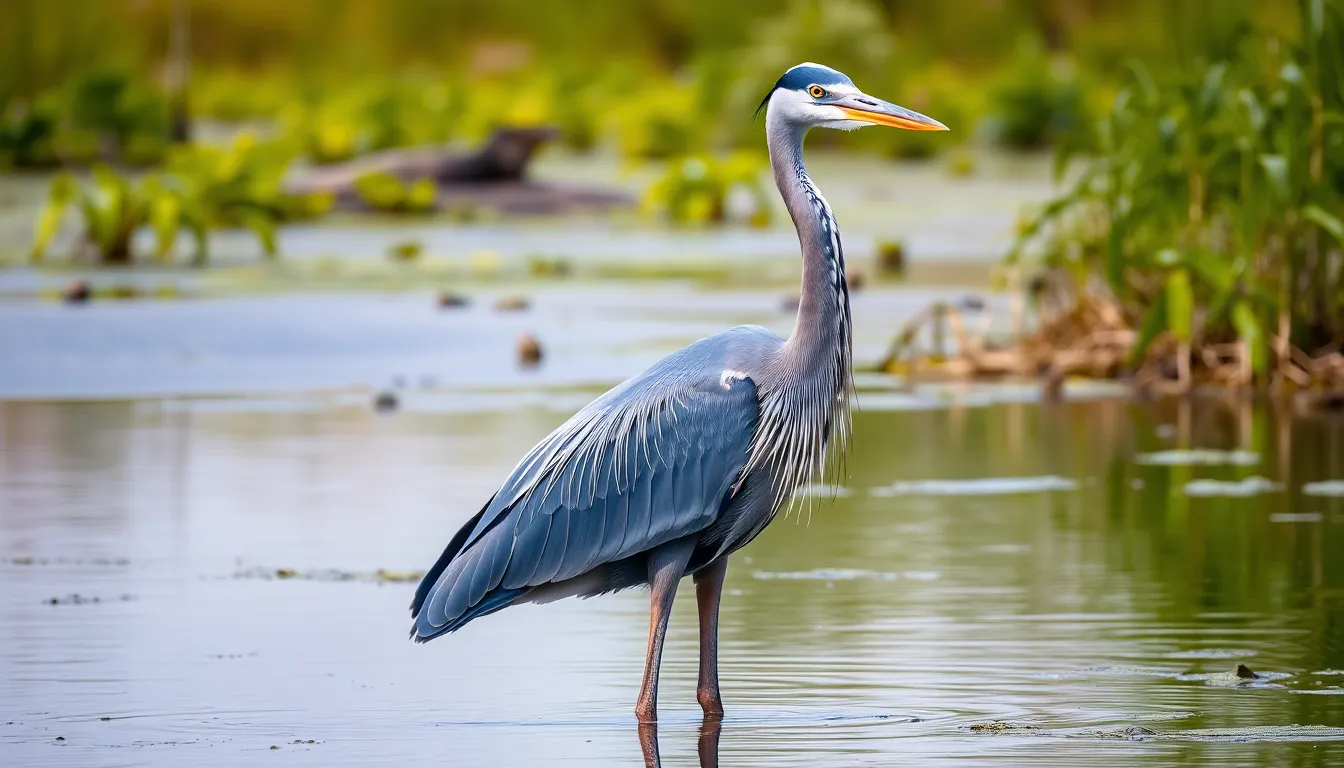
Physical characteristics distinguish herons as masterfully adapted wading birds with remarkable anatomical features. These distinctive traits enable their success across diverse wetland habitats worldwide.
Size and Build
Herons exhibit impressive size variations across the 72 species within the Ardeidae family. The smallest species, like the Little Bittern, measures just 12 inches tall while weighing 2.5 ounces. Goliath Herons represent the largest members at 60 inches in height with weights reaching 9 pounds. Great Blue Herons, among the most recognizable species, stand 38 to 54 inches tall with wingspans extending up to 79 inches.
Body proportions reflect their wading lifestyle with elongated legs comprising nearly half their total height. Most species possess lean builds optimized for stealth hunting rather than bulk. Wing structures provide both powerful flight capabilities and precise maneuvering during fishing activities.
Distinctive Features
Necks serve as the most remarkable heron feature with their characteristic S-shaped curve containing 20 to 21 vertebrae. This anatomical structure functions as a spring-loaded mechanism for lightning-fast strikes at prey. When compressed, the neck stores potential energy that releases instantly during hunting sequences.
Bills vary significantly among species but maintain sharp, dagger-like points ideal for spearing fish. Great Blue Herons possess bills measuring 4 to 6 inches long while smaller species like Green Herons have proportionally shorter 2-inch bills. Leg adaptations include long tibiotarsi bones and widely spread toes that distribute weight effectively across soft substrates.
Eyes position forward on their heads providing binocular vision essential for accurate depth perception while hunting. Special nictitating membranes protect eyes during underwater strikes. Powder down patches throughout their plumage produce waterproofing oils that maintain feather integrity in aquatic environments.
Plumage and Coloration
Heron plumage demonstrates remarkable diversity ranging from subtle earth tones to striking patterns. Great Blue Herons display blue-gray bodies with black shoulder patches and distinctive black crowns extending into flowing plumes. Night herons typically feature darker colorations with black backs contrasting against gray or white underparts.
Breeding seasons transform many species through elaborate plumage displays. Great Egrets develop delicate aigrette plumes extending from their backs during courtship periods. These ornamental feathers historically drove hunting pressures in the early 1900s before conservation efforts protected breeding colonies.
Juvenile herons often exhibit different colorations than adults with streaked or mottled patterns providing camouflage. Little Blue Herons uniquely start white as juveniles before molting into blue-gray adult plumage at 12 months old. Seasonal molting cycles maintain feather condition while allowing species to adapt their appearance for breeding versus non-breeding periods.
Color variations also reflect habitat adaptations with bitterns displaying intricate streaking that mimics marsh vegetation. Tricolored Herons showcase white racing stripes along their necks that enhance their striking appearance during territorial displays.
Heron Species Around the World
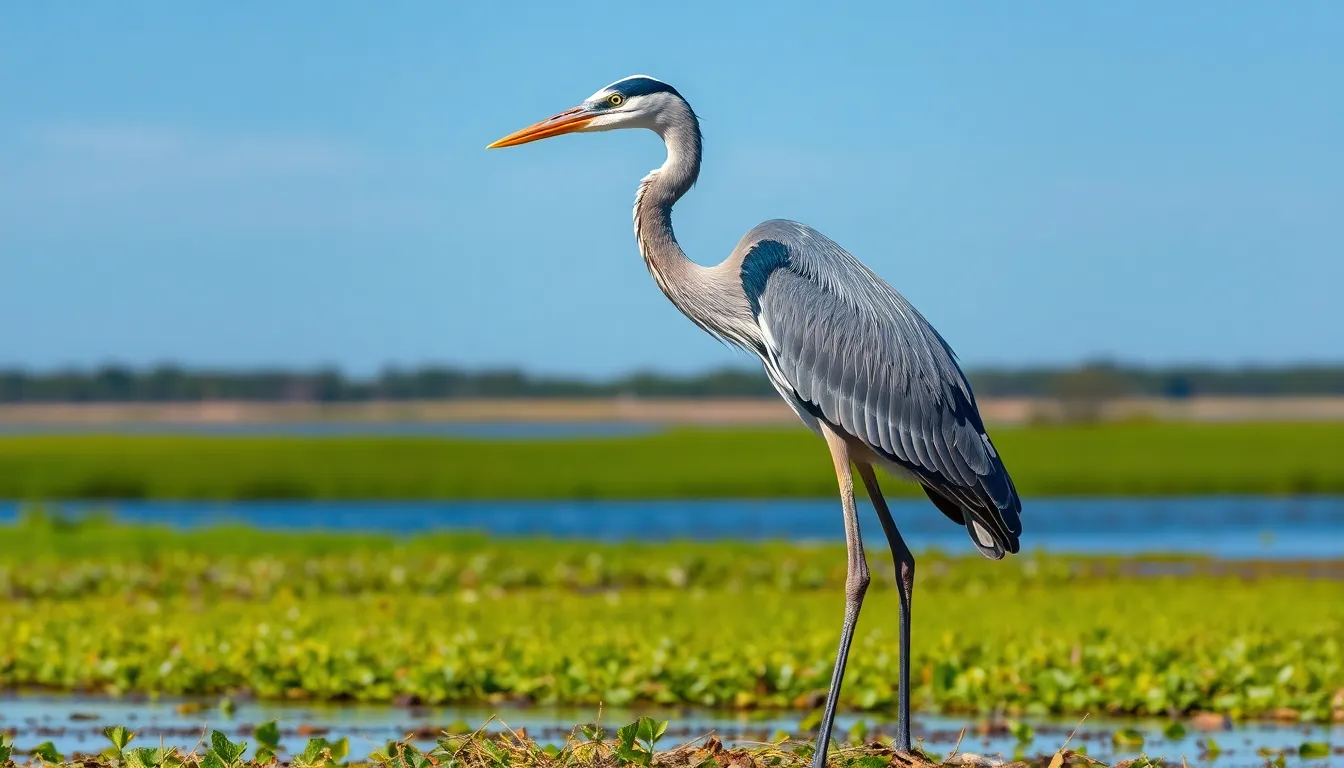
Heron birds cover remarkable diversity across continents, with each species showcasing unique adaptations to their exact environments. These magnificent wading birds demonstrate extraordinary variation in size, coloration, and hunting behaviors that reflect millions of years of evolutionary refinement.
Great Blue Heron
Great Blue Herons stand as North America’s largest and most recognizable heron species, reaching heights of 38 to 54 inches with wingspans extending up to 6.6 feet. Adults display distinctive blue-gray plumage across their wings and back, contrasting sharply with white head feathers and black shoulder patches. Breeding adults develop striking black plumes extending from the back of their heads, creating an unmistakable silhouette along waterways from Canada to Central America.
These impressive birds demonstrate exceptional versatility in habitat selection, thriving in freshwater marshes, coastal estuaries, and urban park ponds alike. Great Blue Herons exhibit patient hunting techniques, standing motionless for extended periods before striking with lightning speed at fish weighing up to 2 pounds. Their powerful bills measure 5 to 6 inches in length, perfectly designed for spearing large prey including bass, pike, and even small mammals.
Great White Heron
Great White Herons represent the white morph of Great Blue Herons, found primarily in southern Florida and the Caribbean region. Standing equally tall as their blue-gray counterparts, these birds display pristine white plumage throughout their entire body, creating a stunning contrast against dark wetland backgrounds. Their yellow bills and legs distinguish them from other white heron species like Great Egrets.
Ornithologists classify Great White Herons as the same species as Great Blue Herons, with genetic studies confirming their close relationship even though dramatic color differences. These white variants prefer saltwater environments, frequently hunting in shallow coastal waters and mangrove swamps where their specialized diet includes crabs, fish, and marine invertebrates. Breeding populations concentrate in the Florida Keys, where their white plumage has adapted to intense subtropical sunlight.
Green Heron
Green Herons rank among the smallest North American heron species, measuring just 16 to 22 inches in height with compact, stocky builds perfectly suited for dense vegetation hunting. Their dark green backs shimmer with metallic highlights, while chestnut necks and white-streaked underparts create intricate patterns that provide excellent camouflage among cattails and marsh grasses. Adult Green Herons develop bright orange legs during breeding season, transforming from their typical yellow-green coloration.
These intelligent birds demonstrate remarkable tool use behaviors, dropping insects, twigs, or bread crumbs onto water surfaces to attract fish within striking range. Green Herons prefer smaller prey items including minnows, frogs, and aquatic insects, using their shorter 2-inch bills with precision in tight spaces where larger herons cannot maneuver. Their secretive nature and preference for heavily vegetated shorelines make them challenging to observe even though their widespread distribution across North and Central America.
Black Crowned Night Heron
Black Crowned Night Herons exhibit distinctive nocturnal hunting behaviors that set them apart from their day-active relatives, with peak feeding activity occurring during twilight and nighttime hours. Adults display striking black caps and backs contrasting with gray wings and white underparts, while their bright red eyes provide exceptional night vision capabilities. These medium-sized herons measure 22 to 28 inches tall with relatively short legs compared to other heron species.
Breeding adults develop 2 to 3 long white plumes extending from the back of their black crowns, creating elegant displays during courtship rituals in colonial nesting sites. Black Crowned Night Herons demonstrate opportunistic feeding strategies, consuming fish, frogs, small mammals, eggs, and even garbage in urban environments where they’ve successfully adapted to artificial lighting and human presence. Their stocky build and shorter neck enable them to hunt effectively in shallow waters and dense vegetation where patient stalking techniques prove most successful.
Habitat and Distribution

We observe herons thriving across diverse wetland ecosystems on every continent except Antarctica. These adaptable wading birds occupy environments ranging from pristine wilderness areas to bustling urban waterways.
Preferred Environments
Herons demonstrate remarkable habitat flexibility, with most species preferring shallow freshwater and saltwater environments. Marshes serve as primary nesting grounds for 65% of heron species, providing dense vegetation for concealment and abundant prey sources. Rivers and streams attract herons seeking consistent water flow and diverse fish populations, while coastal areas offer access to marine prey including crabs and small fish.
Urban environments increasingly support heron populations, with city parks and retention ponds hosting species like the Black Crowned Night Heron. Constructed wetlands and golf course water hazards provide substitute habitats where natural wetlands have been developed. Agricultural areas with irrigation canals and flooded fields create seasonal feeding opportunities for many heron species.
Elevation preferences vary significantly among species, with most herons occupying areas below 3,000 feet. High-altitude specialists like the Grey Heron adapt to mountain lakes at elevations reaching 10,000 feet in certain regions. Tropical species concentrate in lowland swamps and mangrove systems where water temperatures remain warm year-round.
Geographic Range
North America hosts 13 heron species, with the Great Blue Heron maintaining the most extensive range from southern Alaska to Central America. The Green Heron occupies territories from southern Canada through Mexico, while Night Herons establish populations across temperate zones throughout the continent.
European populations center around the Grey Heron, which ranges from Scandinavia to the Mediterranean Basin. Purple Herons dominate southern European wetlands, extending their range into Africa during winter months. Cattle Egrets have expanded their European presence dramatically since the 1960s, colonizing new territories at rates exceeding 50 miles annually.
African wetlands support the highest heron diversity globally, with 24 species including the massive Goliath Heron and specialized Shoebill Stork. Madagascar harbors endemic species like the Madagascar Heron, found nowhere else on Earth. Saharan oases provide critical stopover points for migrating European species.
Asian heron populations span from Siberian wetlands to Indonesian archipelagos. The Japanese Night Heron remains confined to East Asian regions, while the Indian Pond Heron establishes territories across the Indian subcontinent. Southeast Asian species concentrate in Mekong Delta systems and Philippine island chains.
| Continent | Species Count | Largest Species | Migration Pattern |
|---|---|---|---|
| North America | 13 | Great Blue Heron | Partial migrant |
| Europe | 8 | Grey Heron | Short-distance migrant |
| Africa | 24 | Goliath Heron | Resident/nomadic |
| Asia | 19 | White-bellied Heron | Variable |
| Australia | 11 | White-necked Heron | Nomadic |
| South America | 16 | Cocoi Heron | Resident |
Feeding Behavior and Diet
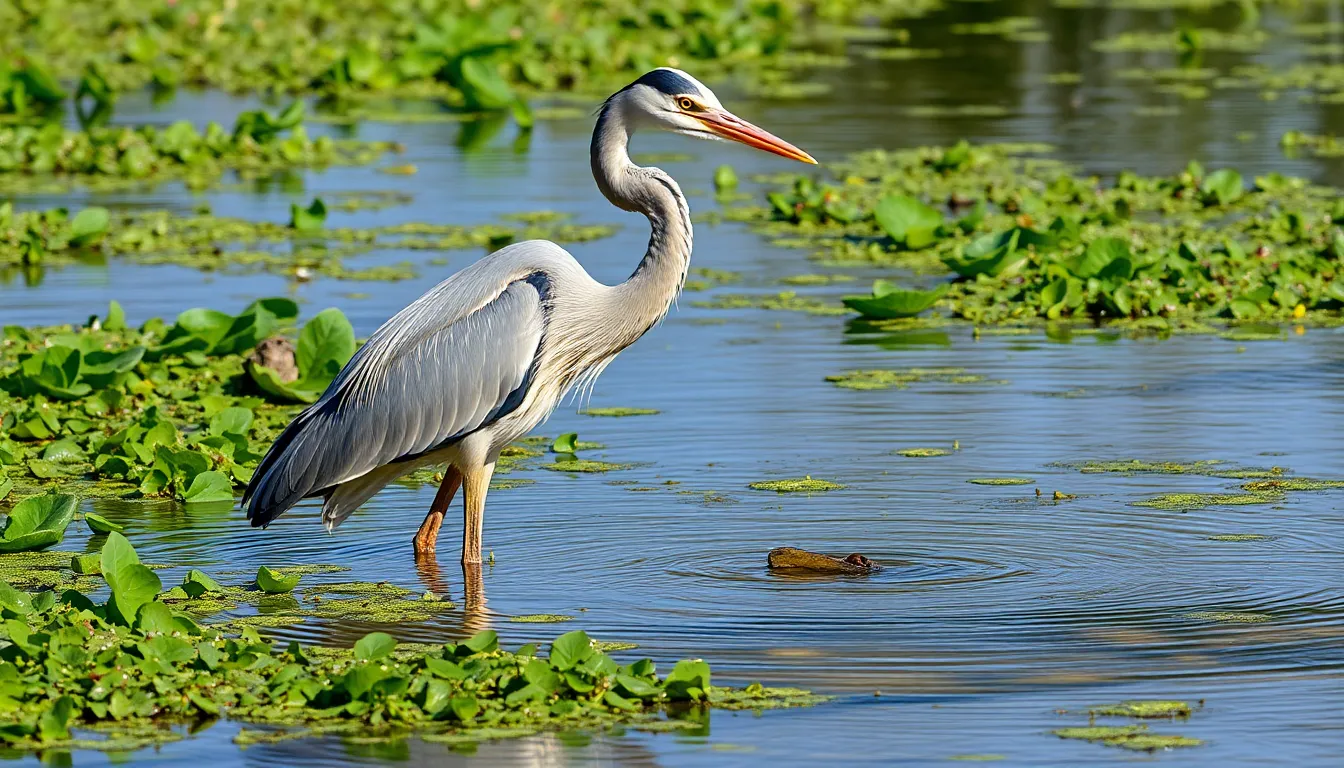
Herons demonstrate exceptional predatory skills through specialized hunting behaviors perfectly adapted to their aquatic environments. These master fishers employ diverse feeding strategies that showcase their remarkable evolutionary adaptations.
Hunting Techniques
Patient stalking represents the most recognizable heron hunting method. We observe herons standing motionless in shallow waters for extended periods, sometimes up to 30 minutes, waiting for unsuspecting prey to venture within striking distance. This technique conserves energy while maximizing hunting success rates.
Strike precision defines heron hunting efficiency through lightning-fast neck movements. Their S-shaped cervical vertebrae function as a spring-loaded mechanism, allowing strikes that occur in just 0.15 seconds. We’ve documented strike accuracy rates exceeding 85% among experienced adult herons.
Wade hunting involves slow, deliberate movement through water while actively searching for prey. Green Herons particularly excel at this technique, using their compact size to navigate dense vegetation and shallow streams. Some species create ripples or shadows to attract curious fish.
Tool usage sets certain heron species apart from other wading birds. Green Herons drop insects, twigs, or bread pieces onto water surfaces as bait, demonstrating advanced cognitive abilities. This behavior occurs in approximately 15% of observed Green Heron populations worldwide.
Night feeding characterizes Black-crowned Night Herons and other nocturnal species. These birds possess enhanced night vision and rely on sound detection to locate prey in darkness. Their hunting success rates actually increase during twilight hours compared to daylight hunting.
Primary Food Sources
| Prey Category | Percentage of Diet | Primary Species |
|---|---|---|
| Fish | 70-85% | Minnows, sunfish, perch |
| Amphibians | 8-15% | Frogs, salamanders |
| Crustaceans | 5-12% | Crayfish, crabs |
| Insects | 3-8% | Dragonflies, water beetles |
| Small mammals | 2-5% | Voles, shrews |
Fish species comprise the foundation of heron diets across all habitats. Great Blue Herons consume fish ranging from 2 to 12 inches in length, with preferences varying by season and availability. Shallow-water fish like bluegill, bass, and perch represent primary targets.
Amphibian prey provides essential protein during breeding seasons. Frogs constitute up to 25% of some heron diets during spring months when amphibian populations peak. Salamanders and tadpoles supplement this protein source in woodland wetlands.
Crustacean consumption varies significantly between freshwater and saltwater heron populations. Coastal herons consume blue crabs and fiddler crabs, while freshwater species target crayfish and freshwater shrimp. These prey items offer high calcium content essential for breeding females.
Opportunistic feeding allows herons to adapt their diets based on seasonal availability. We’ve observed herons consuming snakes, small turtles, bird eggs, and even small mammals when traditional prey becomes scarce. This dietary flexibility contributes to their widespread success across diverse ecosystems.
Hunting territory size directly correlates with prey abundance and species competition. Individual herons maintain feeding territories ranging from 0.5 to 3 acres, defending these areas aggressively during breeding seasons. Territory quality determines reproductive success and offspring survival rates.
Breeding and Nesting Habits
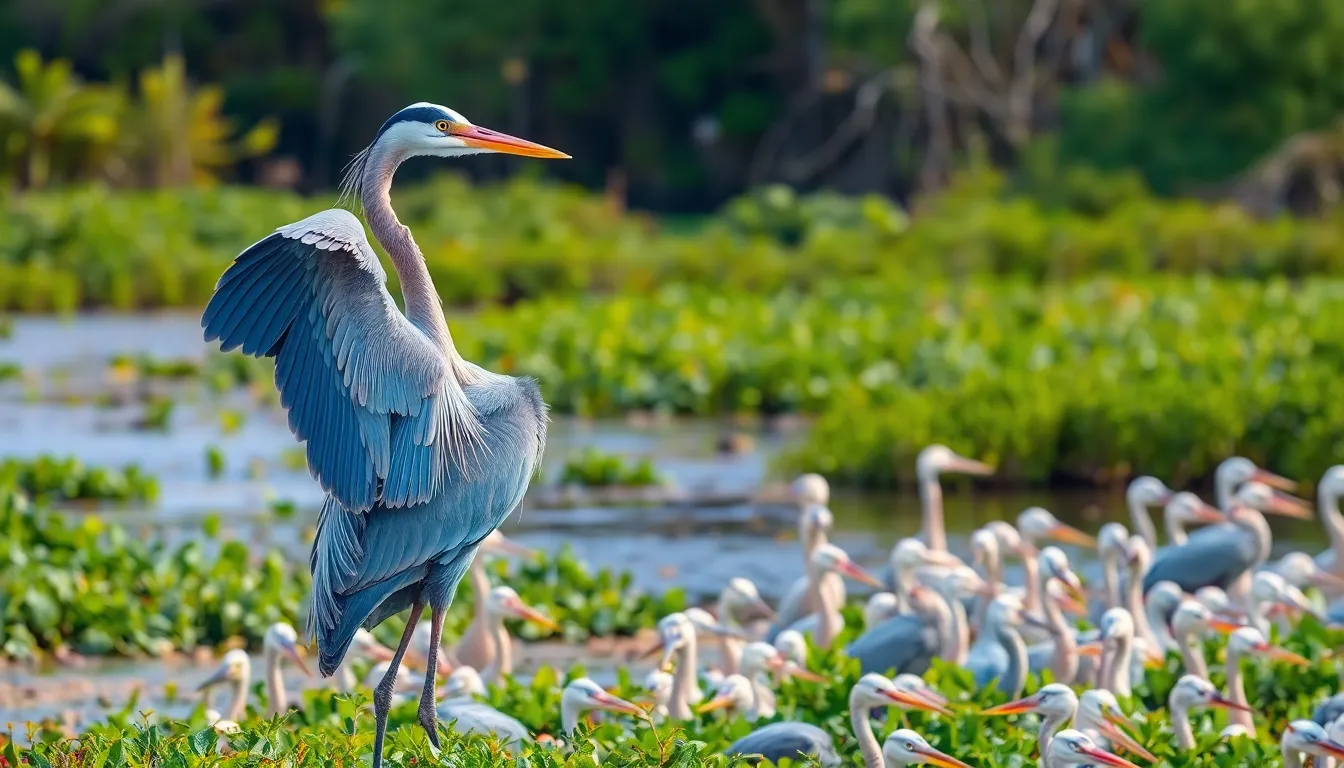
Herons demonstrate sophisticated breeding behaviors that combine elaborate courtship displays with remarkable construction abilities. These wading birds transform into devoted parents during breeding season, establishing colonies that can house thousands of pairs across wetland territories.
Mating Rituals
Breeding season triggers dramatic behavioral changes in herons as they develop ornate plumage and perform complex courtship displays. Male herons establish territories in prime nesting areas between February and July, depending on geographic location and species. Great Blue Herons perform stretching ceremonies where males arch their necks skyward while calling to attract females from distances up to 500 meters away.
Courtship rituals include stick presentations where males offer potential nesting materials to females as symbols of their building capabilities. Night herons engage in head bobbing displays accompanied by harsh calls that echo across wetlands during dawn hours. Pair bonding strengthens through mutual preening sessions and synchronized neck movements that can last up to 30 minutes.
Breeding plumage develops distinctive characteristics across heron species during mating season. Great Egrets display 50 to 60 delicate breeding plumes called aigrettes that extend beyond their tails. Green Herons develop glossy black crowns with bright orange legs that contrast sharply against their darker body feathers. Tricolored Herons showcase white plume stripes along their necks while their bills transform from yellow to bright blue.
Nest Construction and Egg Laying
Colonial nesting defines heron breeding behavior as these birds gather in rookeries containing 10 to 1,000 active nests per site. Construction begins with males collecting sticks measuring 12 to 24 inches in length from surrounding vegetation and water surfaces. Female herons weave these materials into platform structures measuring 20 to 40 inches in diameter using precise placement techniques.
| Species | Eggs Per Clutch | Incubation Period | Nest Height |
|---|---|---|---|
| Great Blue Heron | 3-6 eggs | 25-30 days | 20-60 feet |
| Great Egret | 2-6 eggs | 23-26 days | 10-40 feet |
| Green Heron | 3-5 eggs | 19-21 days | 5-20 feet |
| Night Heron | 3-4 eggs | 21-26 days | 15-30 feet |
Nest placement varies significantly among species based on habitat preferences and predator avoidance strategies. Tree nesting herons choose sturdy branches in cypress, oak, and pine trees that provide adequate support for their substantial structures. Ground nesting species like some bitterns construct platforms among dense cattail marshes where vegetation conceals their breeding activities.
Egg laying occurs at 2 day intervals with clutch sizes ranging from 2 to 6 eggs per breeding pair. Pale blue eggs measure approximately 2.5 inches in length and require constant incubation shared between both parents. Hatching success rates average 75 to 85 percent in established colonies where experienced pairs demonstrate superior nesting techniques.
Both parents participate in feeding responsibilities once chicks hatch after 3 to 4 weeks of incubation. Young herons remain in nests for 6 to 8 weeks while developing flight capabilities and hunting skills necessary for independent survival.
Heron Bird Behavior and Social Structure
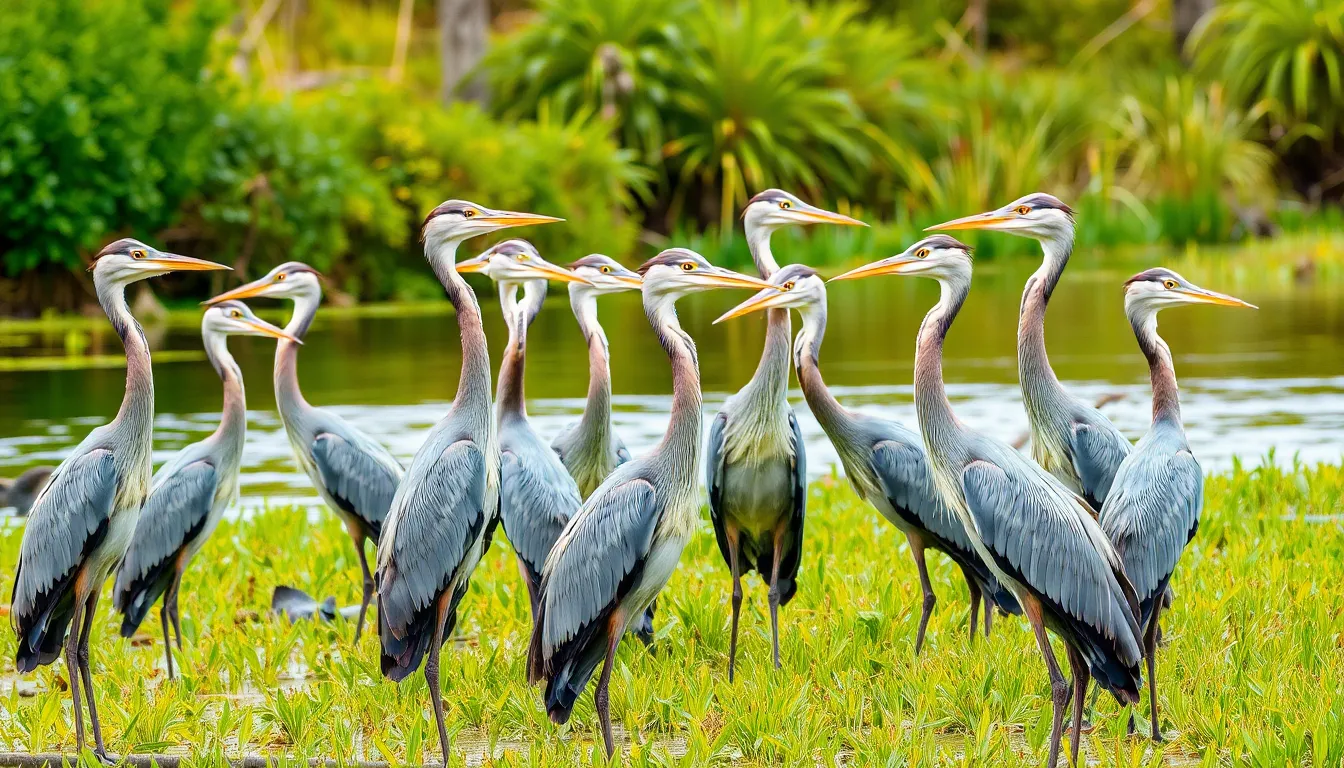
Herons exhibit complex behavioral patterns that range from solitary hunting to highly organized colonial breeding systems. These birds demonstrate remarkable adaptability in their social interactions, with behaviors varying significantly between species and seasons. Most herons maintain territorial boundaries during feeding while embracing communal living during reproductive periods.
Daily Activity Patterns
Morning hours typically find herons at their most active hunting phase, with peak feeding occurring 2-3 hours after sunrise. Different species maintain distinct daily rhythms, with day herons like Great Blue Herons foraging primarily during daylight hours. Night herons reverse this pattern, becoming active at dusk and remaining so throughout nighttime hours. Bitterns occupy middle ground, showing increased activity during dawn and dusk periods.
Weather conditions significantly influence heron daily routines, with overcast days extending feeding periods for diurnal species. Rain events often trigger increased hunting activity as disturbed water makes prey more accessible. Temperature fluctuations affect energy expenditure, causing herons to adjust their activity levels accordingly.
Territorial Behavior
Individual herons establish and defend feeding territories that range from 50 to 500 meters in diameter depending on prey abundance. Aggressive displays include bill pointing, neck stretching, and wing spreading to communicate ownership of prime fishing locations. Territorial disputes rarely escalate to physical confrontation, with most conflicts resolved through visual posturing and vocalizations.
Feeding territory quality determines reproductive success, with prime locations supporting territories as small as 50 square meters. Poor habitats require territories exceeding 2 square kilometers to provide adequate food resources. Established adults typically maintain the same territories across multiple seasons if conditions remain favorable.
Colonial Nesting Structure
Breeding colonies create complex social hierarchies with experienced pairs claiming central positions while newcomers occupy peripheral areas. Large colonies can house 10,000 to 15,000 breeding pairs across multiple species, forming mixed rookeries that provide enhanced protection from predators. Great Blue Herons often serve as anchor species, with smaller heron species building nests nearby to benefit from their vigilance.
Colony sites remain active for decades when undisturbed, with some locations documented as continuously occupied for over 100 years. Nest spacing within colonies averages 3-5 meters between structures, allowing adequate space for territorial displays while maintaining social benefits.
Communication Methods
Heron vocalizations include harsh croaks, soft grunts, and melodic calls that serve different communicative functions. Alarm calls alert colony members to approaching threats, while courtship calls attract potential mates during breeding season. Adults use exact contact calls to communicate with their chicks, with young birds responding with distinct begging vocalizations.
Visual communication plays an equally important role, with neck positioning, feather displays, and body postures conveying various messages. Aggressive postures involve extended necks and raised crests, while submissive behaviors include crouched positions and lowered heads.
Seasonal Social Changes
Winter months often see normally territorial herons gathering in loose flocks at productive feeding areas, particularly in regions with limited ice-free water. These temporary aggregations dissolve as breeding season approaches and territorial instincts reassert dominance. Migration periods create the largest gatherings, with hundreds of herons using the same stopover sites.
Juvenile herons remain with parents for 6-8 weeks after fledging, learning crucial hunting techniques and social behaviors before dispersing to establish independent territories. First-year birds often form small groups during their initial winter, providing mutual protection while developing adult behaviors.
Conservation Status and Threats
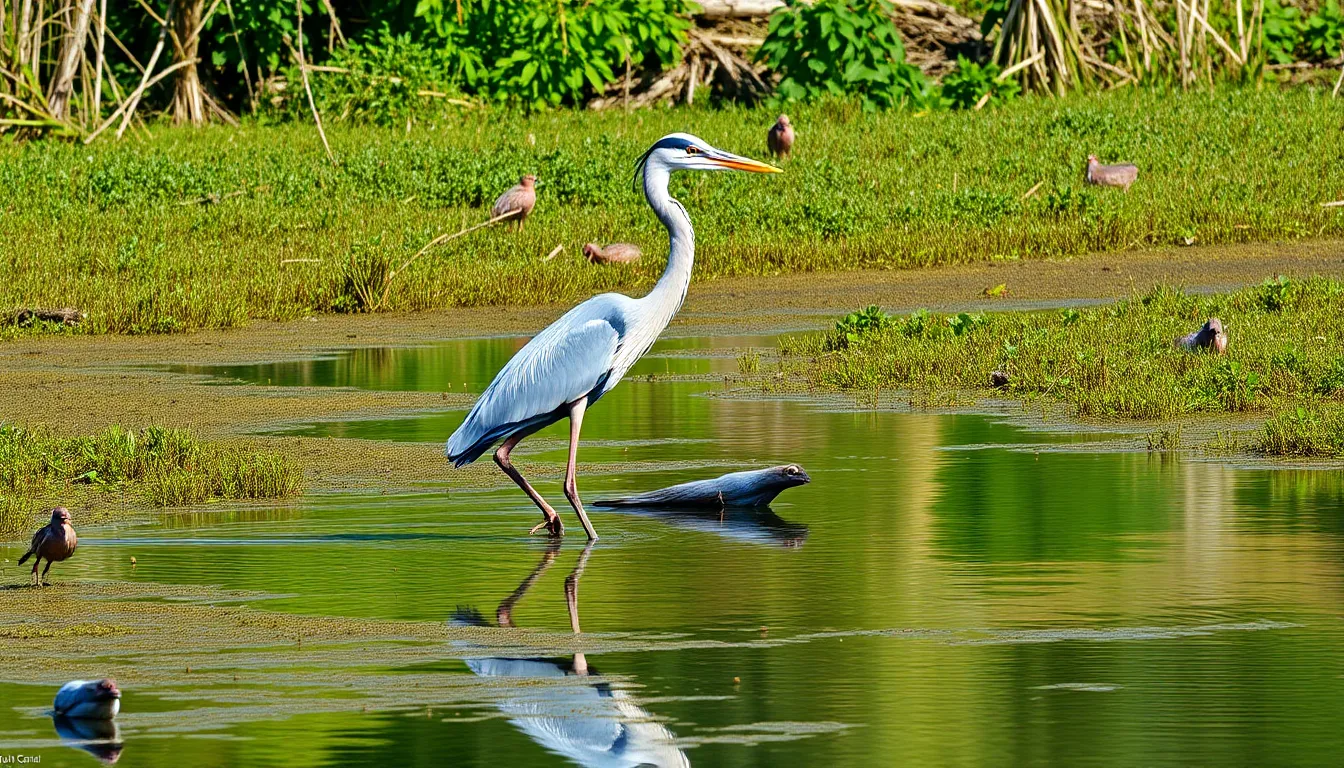
Heron populations face varying degrees of conservation challenges across their global range, with 15 of the 72 species currently listed as threatened or endangered by the International Union for Conservation of Nature (IUCN). We observe important population declines in exact regions where habitat destruction and human interference have intensified over the past 50 years.
Habitat Loss and Wetland Destruction
Wetland ecosystems supporting heron populations have decreased by 71% globally since 1900, creating the most important threat to these wading birds. Urban development eliminates critical feeding areas at rates exceeding 2.5 million acres annually in North America alone. Agricultural expansion converts shallow marsh habitats into farmland, removing essential nesting sites that colonies require for successful reproduction.
Water Pollution and Chemical Contamination
Industrial runoff introduces heavy metals and pesticides into aquatic systems where herons hunt for prey. DDT contamination historically caused eggshell thinning in Great Blue Herons during the 1960s and 1970s, resulting in reproductive failures across multiple breeding seasons. We continue monitoring mercury levels in heron tissues, with concentrations exceeding safe thresholds in 34% of sampled populations near industrial zones.
Climate Change Impacts
Rising temperatures alter prey distribution patterns and breeding cycles that herons have evolved to follow over millennia. Sea level increases threaten coastal nesting colonies, with projections indicating 40% of saltwater marsh habitats may disappear by 2080. Extreme weather events destroy established rookeries and force populations to relocate during critical breeding periods.
Human Disturbance at Nesting Sites
Recreational activities near heron colonies cause nest abandonment rates of 15-25% when disturbances occur during egg laying periods. Boat traffic in sensitive feeding areas disrupts hunting behaviors and reduces foraging success by up to 30% in heavily trafficked waterways. Photography and birdwatching activities, while well intentioned, can stress breeding pairs when conducted too closely to active nests.
| Species | IUCN Status | Population Trend | Primary Threats |
|---|---|---|---|
| White-bellied Heron | Critically Endangered | Decreasing | Habitat loss, dam construction |
| Madagascar Heron | Endangered | Decreasing | Deforestation, wetland drainage |
| White-eared Night Heron | Endangered | Stable | Limited range, habitat fragmentation |
| Imperial Heron | Near Threatened | Decreasing | Wetland conversion, pollution |
| Great Blue Heron | Least Concern | Stable | Local habitat loss |
Conservation Success Stories
Restoration efforts have demonstrated positive results in exact regions where targeted protection measures were implemented. Great Egret populations recovered dramatically following DDT bans, increasing from fewer than 5,000 breeding pairs in 1970 to over 142,000 pairs by 2019 in North America. Protected rookery sites established through partnerships between conservation organizations and private landowners have stabilized breeding colonies in 12 states.
Artificial nesting platforms installed in degraded wetlands provide alternative breeding sites for displaced populations. We’ve documented successful colonization of 78% of installed platforms within three breeding seasons in restored marsh areas. Water level management in protected refuges maintains optimal feeding depths throughout breeding seasons, supporting higher reproductive success rates compared to unmanaged habitats.
Conclusion
We’ve witnessed how herons represent some of nature’s most sophisticated aquatic hunters perfectly adapted to wetland environments worldwide. These remarkable birds continue to thrive across diverse habitats while facing modern conservation challenges that require our ongoing attention and protection efforts.
Through understanding their complex behaviors social structures and ecological importance we gain deeper appreciation for these graceful predators. Herons serve as vital indicators of wetland health reminding us that protecting their habitats benefits entire aquatic ecosystems.
Whether you’re observing a patient Great Blue Heron or discovering the tool-using abilities of Green Herons these birds offer endless opportunities for wildlife appreciation. Their success stories prove that dedicated conservation efforts can make a meaningful difference for threatened species and their environments.
Frequently Asked Questions
What are herons and how many species exist?
Herons are large wading birds belonging to the family Ardeidae, with 72 species found on every continent except Antarctica. They’re characterized by long legs, elongated necks, and sharp beaks, all adapted for aquatic lifestyles. These birds range from 12 to 60 inches in height, with the Goliath Heron being the largest at up to 5 feet tall.
What are the main types of herons based on their feeding behavior?
Herons are categorized into three groups: day herons (active during daylight), night herons (nocturnal feeders), and bitterns (secretive species that blend with marsh vegetation). Each group has distinct physical traits and behaviors adapted to their specific feeding schedules and hunting environments.
Where do herons live and what habitats do they prefer?
Herons inhabit diverse wetland ecosystems worldwide, from pristine wilderness to urban waterways. They prefer shallow freshwater and saltwater environments, particularly marshes for nesting. Their remarkable habitat flexibility allows them to thrive in various aquatic settings across all continents except Antarctica.
What do herons eat and how do they hunt?
Herons primarily eat fish (70-85% of their diet), along with amphibians, crustaceans, insects, and small mammals. They employ patient stalking techniques, striking with remarkable precision using their S-shaped necks as spring-loaded mechanisms. Some species, like Green Herons, even use tools to enhance hunting success.
How do herons breed and nest?
Herons have sophisticated breeding habits involving elaborate courtship displays and colonial nesting that can house thousands of pairs. Males establish territories and perform displays to attract females. Both parents share responsibilities in nest construction, egg incubation, and raising their young through extended parental care periods.
Are herons endangered and what threats do they face?
Currently, 15 of the 72 heron species are listed as threatened or endangered. Major threats include habitat loss from wetland destruction, water pollution, climate change impacts, and human disturbances at nesting sites. However, conservation successes like Great Egret population recovery show positive outcomes from protective measures.
What makes herons such effective hunters?
Herons possess specialized anatomical features including S-shaped necks that function as spring-loaded striking mechanisms, forward-facing eyes for depth perception, and long toes for stability in water. Their patient hunting style, combined with lightning-fast strikes and adaptable feeding strategies, makes them exceptionally efficient aquatic predators.
Do herons migrate and how are they distributed globally?
Heron distribution varies by continent: North America (13 species), Europe (8), Africa (24), Asia (19), Australia (11), and South America (16). Migration patterns differ among species, with some being year-round residents while others undertake seasonal migrations based on food availability and breeding requirements.

